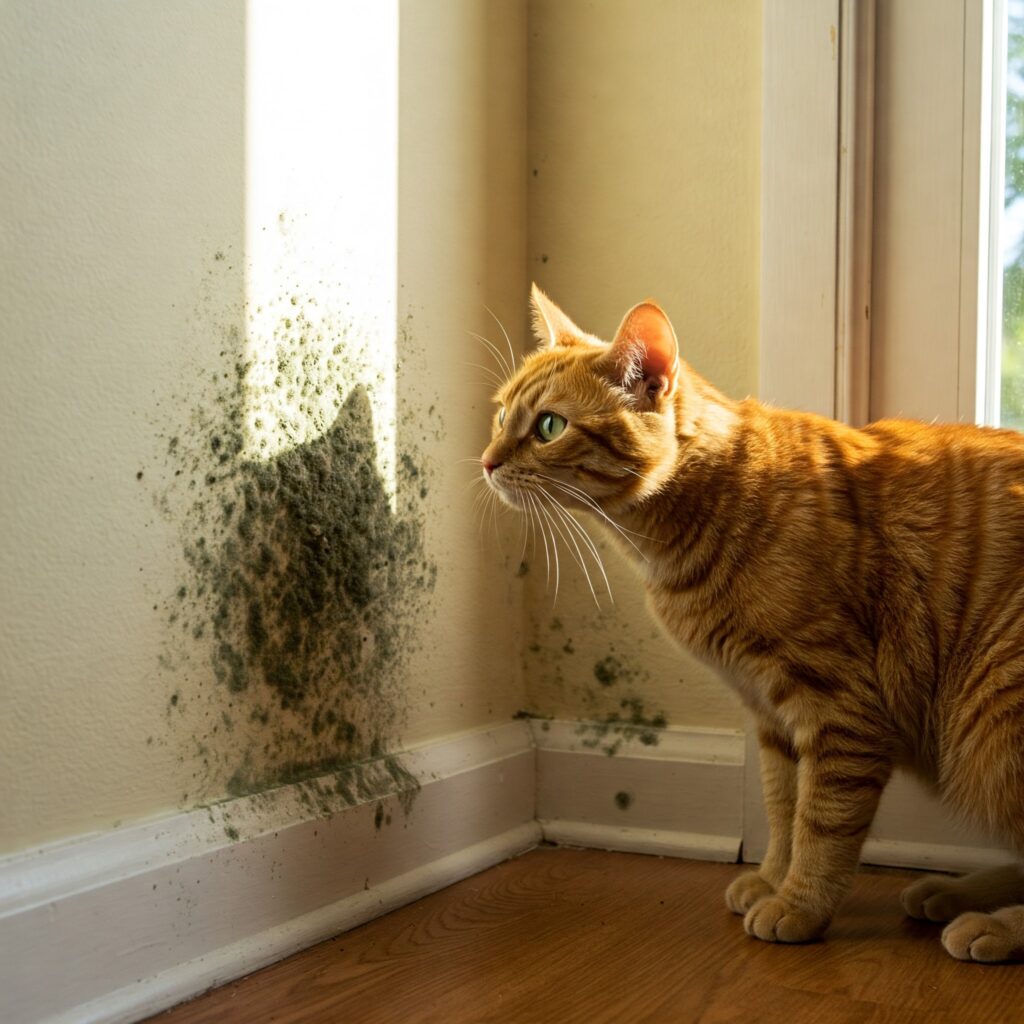Introduction
We meticulously clean our homes, carefully select the best food, and shower our feline companions with love and affection. Yet, many cat parents overlook a silent threat lurking in our homes: indoor allergens. Just like humans, cats can develop sensitivities to environmental triggers that may seriously impact their health and happiness.

As a cat owner, you might notice your furry friend scratching excessively, developing skin issues, or experiencing respiratory problems without understanding why. The culprit could be hiding in plain sight – in your carpet fibers, air ducts, or even that scented candle you love. Indoor allergens affect cats more often than most owners realize, and recognizing the signs early can make all the difference in your pet’s quality of life.
Let’s explore how these hidden household irritants might be affecting your cat and what you can do to create a healthier environment for your beloved pet.
Common Indoor Allergens Affecting Cats
Your home is supposed to be a safe haven for your cat, but it might contain numerous allergens that trigger uncomfortable reactions. Understanding these common indoor irritants is the first step toward helping your feline friend.
Dust Mites: The Microscopic Menace
Dust mites are tiny creatures invisible to the naked eye that feed on dead skin cells and thrive in warm, humid environments. They’re particularly fond of bedding, carpets, and upholstered furniture – all places your cat likely spends significant time.
Did you know? A typical mattress can harbor between 100,000 to 10 million dust mites! Your cat’s bed might be similarly populated, creating a constant source of allergen exposure.
Mold Spores: Hidden in Plain Sight
Basements, bathrooms, and other damp areas in your home can harbor mold, which releases airborne spores that trigger allergic reactions in sensitive cats.

Mold allergies often worsen during humid seasons or after water damage in the home. If your cat suddenly develops respiratory symptoms or increased scratching after a plumbing leak or flood, mold might be the culprit.
Household Chemicals: Everyday Toxins
From floor cleaners to air fresheners, the products we use to keep our homes clean and fresh can irritate our cats’ sensitive respiratory systems.
Common chemical allergens include:
- Synthetic fragrances in air fresheners, candles, and cleaning products
- Ammonia-based cleaners
- Bleach and disinfectants
- Fabric softeners and dryer sheets
- Cigarette smoke and vaping residue
Cat Litter Dust: A Daily Exposure
That cloud of dust when you pour fresh litter isn’t just annoying—it could be triggering allergic reactions in your cat. Clay-based litters tend to be particularly dusty, and the added fragrances in some varieties compound the problem.
Indoor Pollen Sources: Unexpected Culprits
While we typically associate pollen with outdoor allergies, houseplants, dried flowers, and even tracked-in outdoor pollen can cause reactions in sensitive cats.
Recognizing the Signs of Allergies in Your Cat
Cats can’t tell us when they’re feeling unwell, so it’s crucial to recognize the signs that might indicate your feline friend is suffering from allergies. Early detection allows for prompt intervention, potentially preventing more serious health issues down the road.
Skin Symptoms: The Most Common Signs

The majority of allergic cats will show skin-related symptoms, which may include:
- Excessive grooming or licking – particularly focused on one area
- Hair loss – often in patches or along the back or abdomen
- Red, irritated skin
- Scratching beyond normal grooming behavior
- Small scabs or “miliary dermatitis” – often felt as tiny bumps when petting
Respiratory Symptoms: When Breathing Becomes Difficult
While less common than skin reactions, respiratory symptoms can indicate a serious allergic response:
- Sneezing fits
- Watery eyes or discharge
- Wheezing or coughing
- Increased respiratory rate
- Difficulty breathing (seek immediate veterinary care if noticed)
Behavioral Changes: Subtle but Telling
Sometimes the signs of discomfort are behavioral rather than physical:
- Irritability or increased aggression
- Lethargy or decreased activity
- Avoiding certain rooms or areas of the house
- Changed sleeping locations
- Reduced appetite
Are Some Cats More Susceptible to Indoor Allergens?
Just like humans, some cats are genetically predisposed to developing allergies. Understanding these risk factors can help you be more vigilant if your cat falls into a higher-risk category.
Breed Predispositions
Research has shown that certain cat breeds are more likely to develop environmental allergies:

If you own one of these breeds, it’s worth being extra attentive to potential allergy symptoms and creating a low-allergen environment proactively.
Age and Immune System Development
Kittens and senior cats often have more sensitive immune systems, making them more susceptible to developing allergic reactions. Most cats develop environmental allergies between 1-3 years of age, but symptoms can appear at any time in a cat’s life.
Interesting fact: Just like humans, cats can suddenly develop allergies to things they’ve been exposed to for years without previous issues!
Diagnosing Environmental Allergies in Cats
If you suspect your cat is suffering from indoor allergen sensitivities, proper diagnosis is essential for effective treatment. Let’s explore how veterinarians identify these invisible triggers.
When to See the Vet
Consider scheduling a veterinary appointment if:
- Symptoms persist for more than a week
- Your cat seems in obvious discomfort
- There’s excessive scratching leading to open wounds
- Respiratory symptoms are present
- Behavioral changes are significant
Diagnostic Approaches
Your veterinarian might use several methods to determine if indoor allergens are affecting your cat:
Blood Tests: These measure antibody levels against specific allergens and can identify sensitivities to common household triggers.
Skin Prick Tests: Similar to allergy testing in humans, this involves injecting small amounts of potential allergens under the skin and monitoring for reactions.
Elimination Trials: This systematic approach involves removing potential allergens from your cat’s environment one by one and monitoring for improvement.

Creating an Allergen-Free Environment for Your Cat
Once you’ve identified the culprits behind your cat’s allergic reactions, it’s time to tackle your home environment. These practical strategies can significantly reduce indoor allergens and improve your cat’s comfort.
Effective Cleaning Strategies
Regular Vacuuming: Invest in a vacuum with a HEPA filter, like the Dyson Animal Vacuum, to trap allergens effectively. Pay special attention to areas where your cat spends the most time.
Washing Bedding: Clean your cat’s bedding weekly in hot water (at least 130°F) to kill dust mites.
Reducing Clutter: Minimize knickknacks, books, and other dust-collecting items, particularly in rooms your cat frequents.
Damp Dusting: Use a microfiber cloth dampened with water to trap dust rather than sending it airborne.
Air Quality Improvements
HEPA Air Purifiers: Place these devices in rooms where your cat spends the most time to filter out airborne allergens like pollen, dust, and mold spores.
Humidity Control: Maintain indoor humidity between 40-50% to discourage dust mite and mold growth. Consider a dehumidifier in damp areas.
Ventilation: Ensure proper ventilation, especially in kitchens and bathrooms, to reduce moisture and prevent mold.
Product Swaps for Sensitive Cats
Making simple product switches can dramatically reduce your cat’s exposure to irritants:
- Replace scented litter with hypoallergenic, dust-free alternatives
- Switch to fragrance-free, natural cleaning products
- Eliminate air fresheners, scented candles, and essential oil diffusers
- Opt for unscented laundry detergent for washing your cat’s bedding
Medical Treatments for Cats with Environmental Allergies
When environmental changes aren’t enough to control your cat’s symptoms, medical interventions may be necessary. Always consult with your veterinarian before starting any medication regimen.
Medications That Can Help
Antihistamines: Some human antihistamines like Claritin (loratadine) can be prescribed for cats at appropriate dosages, though effectiveness varies between individuals.
Corticosteroids: These powerful anti-inflammatory medications quickly reduce itching and inflammation but are typically used short-term due to potential side effects.
Immunotherapy: Similar to allergy shots in humans, this long-term treatment gradually exposes your cat to increasing amounts of allergens to build tolerance.
Specialty Shampoos: Medicated baths can remove allergens from your cat’s coat and soothe irritated skin.
Supplements for Immune Support
Several supplements may help strengthen your cat’s immune system and reduce allergic reactions:
- Omega-3 fatty acids (found in PetHonesty Skin & Coat Chews)
- Probiotics (like Nutramax Proviable-DC)
- Quercetin (a natural antihistamine found in some pet supplements)
- L-lysine (VetriScience Laboratories Lysine)
Special Considerations for Multi-Pet Households
Managing allergens becomes more complex when you have multiple pets. Here are some strategies specifically for homes with more than one furry family member:
Cross-Reactivity Concerns
If you have both dogs and cats, be aware that products used for one pet may trigger reactions in another. This includes:
- Flea treatments
- Shampoos
- Medications
- Pet-specific cleaning products
Designated Spaces
Consider creating allergen-controlled zones where your sensitive cat can retreat:
- A bedroom with minimal fabrics and dust-collecting items
- Elevated spaces away from floor dust and dander
- Areas without carpeting or heavy upholstery
Real-Life Success Stories: Cats Who Overcame Indoor Allergies
Sometimes the best motivation comes from hearing about others who’ve successfully navigated similar challenges. Here are two inspiring stories from cat parents who helped their allergic feline friends find relief.
Whiskers’ Breathing Breakthrough
Twelve-year-old Whiskers had developed a persistent cough and seemed increasingly lethargic. His owner, Maria, noticed the symptoms worsened after she cleaned the house. After consulting with her veterinarian, she discovered Whiskers had developed an allergy to her cleaning products.
Maria switched to natural, fragrance-free alternatives and installed HEPA air purifiers throughout her home. Within weeks, Whiskers’ coughing subsided, and his playful personality returned. Now, Maria maintains a strict cleaning regimen using only cat-safe products, and Whiskers remains symptom-free.
Luna’s Itchy Skin Solution
Luna, a Siamese cat with sensitive skin, had developed bald patches and scabs despite multiple treatments. Her owner, James, worked with a veterinary dermatologist to identify dust mites as the primary culprit.
James implemented a comprehensive approach:
- Replacing carpeting with hardwood floors
- Purchasing mite-proof covers for all bedding
- Weekly hot-water washing of Luna’s bedding
- Adding omega-3 supplements to Luna’s diet
The transformation was remarkable—Luna’s fur grew back within months, and her constant scratching became a thing of the past.
Frequently Asked Questions About Cats and Indoor Allergens
What are the most common environmental allergens for cats?
The most prevalent indoor allergens affecting cats include dust mites, mold spores, household cleaning chemicals, cigarette smoke, and synthetic fragrances. Even indoor cats that never go outside can develop sensitivities to these common household irritants.
How do I know if my cat has environmental allergies?
Look for telltale signs like excessive scratching, licking, or grooming; red, irritated skin; hair loss; sneezing fits; watery eyes; or inflamed paws. Behavioral changes such as irritability or lethargy can also indicate discomfort from allergies.
Can indoor cats develop environmental allergies?
Absolutely! Indoor cats can develop allergies to dust, mold, or chemical irritants like air fresheners or litter dust. In fact, because indoor cats spend 100% of their time exposed to these household allergens, they may be even more likely to develop sensitivities than outdoor cats.
Are certain cat breeds more prone to environmental allergies?
Yes, genetics play a significant role in allergy susceptibility. Siamese, Abyssinian, and Devon Rex cats have a genetic predisposition to developing environmental allergies. If you own one of these breeds, being proactive about allergen control is especially important.
How are environmental allergies diagnosed in cats?
Veterinarians typically diagnose allergies through blood tests, skin prick tests, or elimination trials. The process involves identifying specific allergens triggering your cat’s symptoms, which allows for targeted treatment approaches.
Can environmental allergies cause vomiting or diarrhea in cats?
While uncommon, severe allergic reactions may occasionally trigger digestive issues like vomiting or diarrhea. However, skin and respiratory symptoms are much more typical. If your cat experiences persistent digestive problems, consult your veterinarian to rule out other potential causes.
What home remedies help reduce environmental allergens?
Effective home strategies include frequent vacuuming with a HEPA-filter vacuum, using air purifiers in rooms where your cat spends time, washing bedding in hot water weekly, and providing hypoallergenic bedding. Keeping humidity levels between 40-50% also helps control dust mites and mold.
Is Claritin safe for cats with allergies?
Claritin (loratadine) can be used for cats, but only under veterinary guidance for proper dosage. Never administer human medications to your cat without consulting your vet first, as improper dosing can be dangerous or even fatal.
Can environmental allergies be cured in cats?
Environmental allergies cannot be completely cured, but symptoms can be effectively managed through a combination of allergen avoidance, medication when necessary, and environmental modifications. With proper management, most allergic cats can live comfortable, symptom-free lives.
Do air purifiers help cats with pollen allergies?
Yes, HEPA air purifiers are highly effective at removing airborne allergens like pollen, dust, and mold spores. Placing purifiers in rooms where your cat spends the most time can significantly reduce symptoms, especially during high-pollen seasons when outdoor allergens may be tracked indoors.
Conclusion: Creating a Healthier Home for Your Allergic Cat
Living with an allergic cat might seem overwhelming at first, but with knowledge and consistent effort, you can create an environment where your feline friend thrives. Remember that managing indoor allergens isn’t just about addressing symptoms—it’s about improving your cat’s overall quality of life.
Start by identifying potential allergens in your home and implementing the cleaning and environmental modifications we’ve discussed. Monitor your cat’s response to these changes, and don’t hesitate to work with your veterinarian to explore medical options if needed.
Most importantly, be patient. Finding the right combination of environmental controls and treatments might take time, but the reward—seeing your cat comfortable and happy again—is well worth the effort.
Your Turn: Have you noticed allergy symptoms in your cat? Which strategies from this article will you try first? Share your experiences or questions in the comments below!
